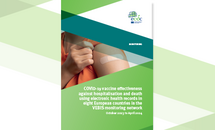COVID-19 vaccine effectiveness against hospitalisation and death using electronic health records in eight European countries in the VEBIS monitoring network - October 2023 to April 2024
This document reports the results of prospective monitoring of COVID-19 vaccine effectiveness.
Executive summary
This report presents pooled vaccine effectiveness (VE) estimates for the Pfizer XBB.1.5 monovalent COVID-19 vaccine dose against hospitalisation and COVID-19-related death in resident populations in eight European countries. The dose was administered during the 2023 autumn campaign against COVID-19. The study populations were those aged ≥65 years living in the community in Belgium, Denmark, Italy, the Netherlands (only until December 2023), Norway (only until February 2024), Portugal, Spain (Navarra) and Sweden (data coverage to 15 April 2024). The study was undertaken within the Vaccine Effectiveness Burden and Impact Studies (VEBIS) project.
The study period covered in this report is October 2023 to April 2024. A retrospective cohort was constructed from linked electronic health records (EHR) in each country. Country-specific (level) VE was estimated monthly, using a study period of eight weeks follow-up period. Each month, the study period was shifted forwards to the next month. Country estimates were then pooled together for each period. The VE of the 2023 autumnal dose was estimated using the not-yet-vaccinated eligible population as a reference population.
Between October 2023 and April 2024, the number of individuals aged ≥80 years included in the analysis across each study period decreased from five to four million individuals who were eligible for the 2023 autumnal dose, but who did not receive it during the study period. In the 65-79-year age group, the number of individuals eligible for the autumnal dose but who did not receive it decreased from 12.5 to 9.8 million individuals. A total of 63 876 hospitalisations due to COVID-19 and 8 212 COVID-19-related deaths were reported.
Individuals who received the 2023 autumnal dose had already received a higher number of COVID-19 vaccine doses by then compared to those who were eligible but had not received the autumnal dose by the end of the study period. There was also a higher proportion of individuals with registered co-morbidities who received the vaccination. The effectiveness of the monovalent XBB.1.5 COVID-19 vaccine dose against hospitalisation due to COVID-19 for the first eight-week observation window (from the start of the campaigns in October to 25 November 2024) was 65% (95%CI: 56 to 71) and 64% (95%CI: 55 to 72) among the population aged ≥80 and 65-79 years, respectively. Vaccine effectiveness against COVID-19-related death was 67% (95%CI: 41 to 81) and 67% (95%CI: 43 to 81) among the population aged ≥80 and 65-79 years, respectively.
Vaccine effectiveness against hospitalisation due to COVID-19 decreased steadily through the study period, down to 38% (95%CI: 31 to 45) and 48% (95%CI: 40 to 55) among the population aged ≥80 and 65-79 years, respectively, on 1 January to 25 February 2024. Most of this decrease may be attributable to new SARS-CoV-2 variants becoming dominant, increasing time since vaccination in the majority of the vaccinated population who received it in October, or even to biases, such as a depletion of susceptible individuals. Between February 2024 and April 2024, estimates had very low precision or could not be drawn in some sites.
Vaccine effectiveness estimates against COVID-19 related deaths decreased similarly to VE against hospitalisation for ≥80-year-olds, but only marginally among the 65-79 years old group. From 1 January to 25 February 2024, VE against death was 40% (95%CI: 25 to 51) for ≥80-year-olds and 54% (95%CI: 24 to 71) for 65-79-year-olds. Between February and April 2024 estimates had very low precision or could not be drawn in some sites.
Overall, the results of this study indicate that the 2023 autumnal dose was effective in restoring protection against hospitalisation and COVID-19-related death. However, VE declined over time and reached ≤55% for both outcomes and age groups after January 2024.








